- Become A Member
- Gift Membership
- Kids Membership
- Other Ways to Give
- Explore Worlds
- Defend Earth

How We Work
- Education & Public Outreach
- Space Policy & Advocacy
- Science & Technology
- Global Collaboration
Our Results
Learn how our members and community are changing the worlds.
Our citizen-funded spacecraft successfully demonstrated solar sailing for CubeSats.
Space Topics
- Planets & Other Worlds
- Space Missions
- Space Policy
- Planetary Radio
- Space Images
The Planetary Report
The eclipse issue.
Science and splendor under the shadow.
Get Involved
Membership programs for explorers of all ages.
Get updates and weekly tools to learn, share, and advocate for space exploration.
Volunteer as a space advocate.
Support Our Mission
- Renew Membership
- Society Projects
The Planetary Fund
Accelerate progress in our three core enterprises — Explore Worlds, Find Life, and Defend Earth. You can support the entire fund, or designate a core enterprise of your choice.
- Strategic Framework
- News & Press
The Planetary Society
Know the cosmos and our place within it.
Our Mission
Empowering the world's citizens to advance space science and exploration.
- Explore Space
- Take Action
- Member Community
- Account Center
- Eclipse 2024
- “Exploration is in our nature.” - Carl Sagan
Emily Lakdawalla • Feb 24, 2012
This is how far human radio broadcasts have reached into the galaxy
The other day, I was playing around with stumbleupon and came across this photo, which -- well, it speaks for itself. Wow.
Gives you perspective, doesn't it? Actually, I'm a little surprised that the dot shows up on this image at all. Some people describe this as humbling, but for me, I see it as just the beginning. I'm very grateful to be a member of the very few generations of humanity that have ever lived who are (a) capable of creating radio broadcasts and (b) realizing how much more of the universe there is beyond what we've experienced.
I tweeted a link to it, and while I expected some retweets, I was surprised to see its spread -- I think it's probably the single most retweeted tweet I have ever written. There's probably several reasons for that. Links to photos are more likely to be retweeted than others. Very short but still substantial tweets are more likely to be retweeted, because it gives the repeater scope for their own commentary. And this is the sort of thing that can make just about anybody who is capable of operating a cell phone go "hmm," so it has wide appeal.
The one thing I feel bad about is that stumbleupon sent me directly to the photo on somebody else's website, and I didn't bother looking up its origin before I tweeted the link. So now I have, and I can tell you that the diagram was made by Adam Grossman on the jackadamblog , using an artist's concept of the Milky Way by Nick Risinger that he took from Wikipedia. They have a neato-looking iOS app, Dark Sky , that provides very short-term weather predictions. My apologies, Adam, for sending so much traffic directly to the photo rather than to your blog! Hopefully this post will correct that error.
A special note to the pedants: yes, I do realize that the signal from our radio and TV broadcasts is so attenuated by that 100-light-year boundary as to be undetectable except by some kind of magical alien technology. That's not the point. Don't be so literal!
One last thing: my apologies for no post yesterday and the likelihood of very few posts next week. I have a lot of other projects going right now that do not automatically produce blog posts, and not enough time.
Let’s Go Beyond The Horizon
Every success in space exploration is the result of the community of space enthusiasts, like you, who believe it is important. You can help usher in the next great era of space exploration with your gift today.
For full functionality of this site it is necessary to enable JavaScript. Here are instructions on how to enable JavaScript in your web browser .
Galactic Map of Every Human Radio Broadcast Reveals How Isolated We Are
Those aliens better be nearby.
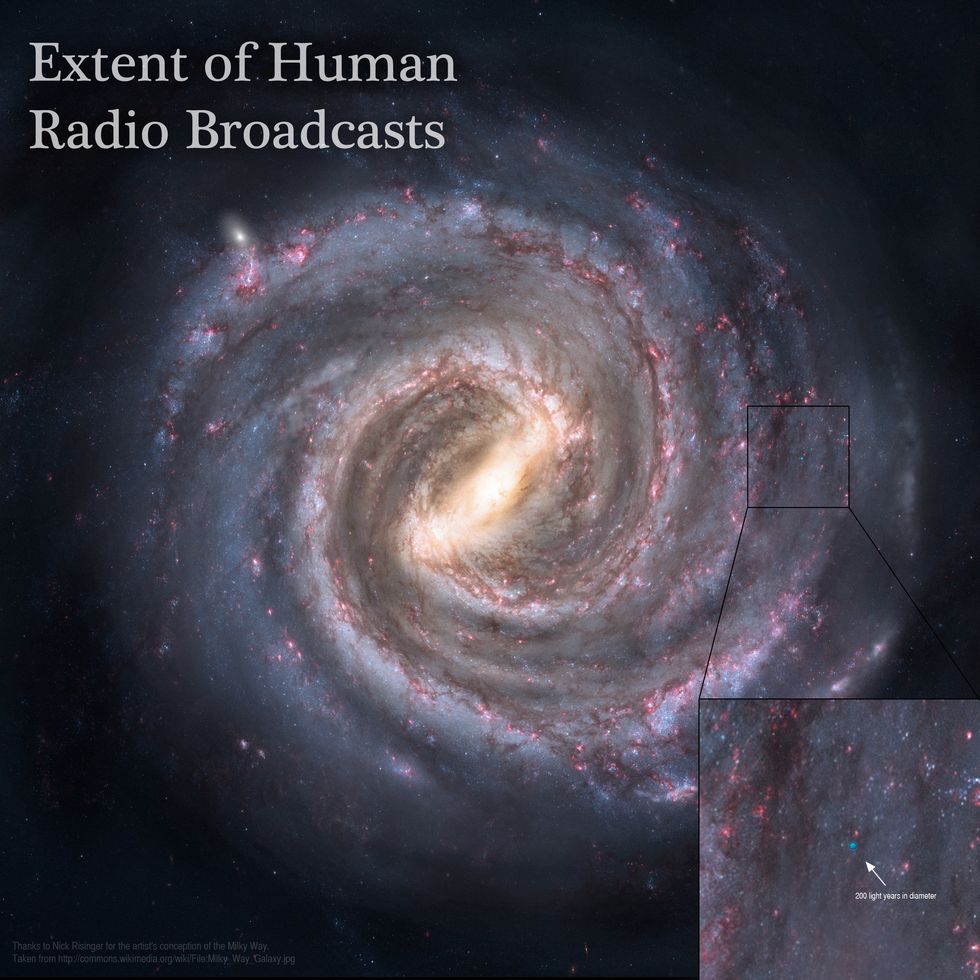
This map designed by Adam Grossman of The Dark Sky Company puts into perspective the enormity of these scales. The Milky Way stretches between 100,000 and 180,000 light-years across, depending on where you measure, which means a signal broadcast from one side of the galaxy would take 100,000 years or more to reach the other side. Now consider that our species started broadcasting radio signals into space only about a century ago. That's represented by a small blue bubble measuring 200 light-years in diameter surrounding the position of the Earth. For any alien civilizations to have heard us, they must be within the bubble.
The very first experimentation with electromagnetic radiation was conducted some 200 years ago, when Danish physicist and chemist Hans Christian Ørsted discovered that electric currents create magnetic fields. This research was expanded by scientists including Michael Faraday , and it eventually resulted in James Clerk Maxwell 's theory of electromagnetism outlined in 1865 and demonstrated by German physicist Heinrich Hertz's experiments more than two decades later. Even then, it wasn't until Italian inventor and electrical engineer Guglielmo Marconi developed long-range radio transmission technologies around the turn of the 20th century that our species really started broadcasting its existence out into the void.
.css-2l0eat{font-family:UnitedSans,UnitedSans-roboto,UnitedSans-local,Helvetica,Arial,Sans-serif;font-size:1.625rem;line-height:1.2;margin:0rem;padding:0.9rem 1rem 1rem;}@media(max-width: 48rem){.css-2l0eat{font-size:1.75rem;line-height:1;}}@media(min-width: 48rem){.css-2l0eat{font-size:1.875rem;line-height:1;}}@media(min-width: 64rem){.css-2l0eat{font-size:2.25rem;line-height:1;}}.css-2l0eat b,.css-2l0eat strong{font-family:inherit;font-weight:bold;}.css-2l0eat em,.css-2l0eat i{font-style:italic;font-family:inherit;} Even if you threw 100 darts, it's a near certainty that none would land in the little blue bubble of our radio waves
If we are optimistic, and we assume an advanced extraterrestrial species has the technological capabilities to detect humanity's very first radio waves (and distinguish them from the general background noise of the universe), we can estimate our farthest signals are a little more that 100 light-years away. If you threw a dart at the map of the Milky Way, and wherever that dart landed is where an advanced alien species resides, there would be a cosmically small probability that they live close enough to be aware of our existence. Even if you threw 100 darts, it's a near certainty that none would land in the little blue bubble of our radio waves.
The search for extraterrestrial intelligence (SETI) institute is constantly listening with our most capable radio telescopes , and they are broadcasting messages from us as well. But given the sheer size of the galaxy, SETI will likely have to listen and transmit for tens of thousands of years at least to have a chance of making contact with another intelligent species—and even that might not be long enough. Perhaps, in the meantime, we should contemplate Carl Sagan's next line in his Pale Blue Dot speech:
"In our obscurity, in all this vastness, there is no hint that help will come from elsewhere to save us from ourselves."
Source: Planetary Society

Jay Bennett is the associate editor of PopularMechanics.com. He has also written for Smithsonian, Popular Science and Outside Magazine.

.css-cuqpxl:before{padding-right:0.3125rem;content:'//';display:inline;} Space .css-xtujxj:before{padding-left:0.3125rem;content:'//';display:inline;}
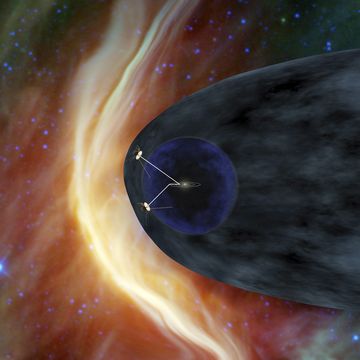
Stream the Great American Solar Eclipse

Human-Made Space Debris Could Crash on Mars

How to View the Solar Eclipse
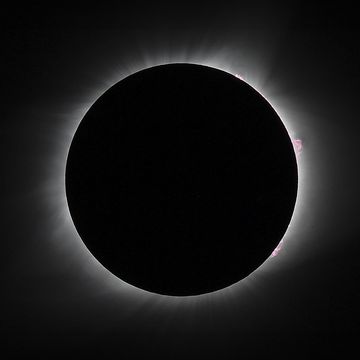
The Path of Totality for the Solar Eclipse

Shop the Walmart Solar Eclipse Bundle

How a Lunar Supercollider Could Upend Physics

SpaceX Is Working on a Shadowy Government Project

The Moon Is Going Nuclear

Private Company to Mine Helium-3 from the Moon
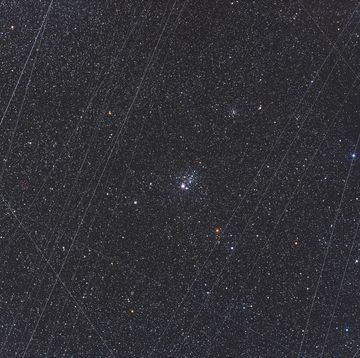
Too Many ‘UFOs’ Are Actually Starlink Satellites
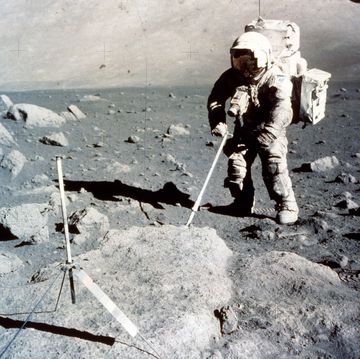
The Incredible Case of NASA’S Missing Moondust
Are Radio Waves Light Waves? Everything You Need to Know!
Last Updated on Mar 12 2024
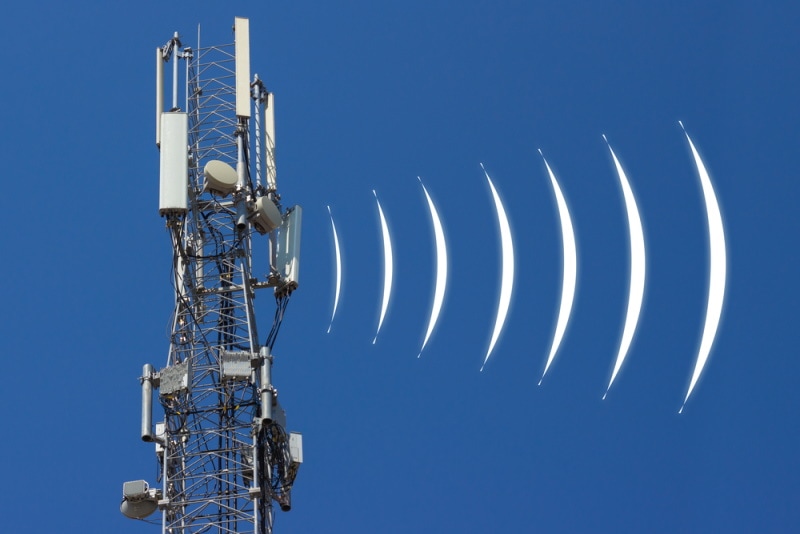
Radio waves are light waves because they’re made up of photons, little particles of energy that vibrate along the electric and magnetic fields. If our eyes could perceive radio waves, looking up at the night sky would reveal a world of colors that are otherwise invisible to us, and communications towers would emit rainbow-colored waves into the atmosphere.
That said, when people say, “light waves,” they might be referring to visible light , the only part of the electromagnetic spectrum that is visible to the naked eye. Sometimes, infrared and ultraviolet, which are not visible to us, are included. Along with Infrared, visible light, ultraviolet, x-rays, gamma rays, and microwaves, radio waves are better referred to as electromagnetic radiation.
- Do Radio Waves Travel at the Speed of Light?
It’s easy to think that radio waves travel at the speed of sound. After all, most of us immediately associate the word, radio, with listening to music or the news. But radio waves are light waves , and therefore, they travel at lightspeed. In the vacuum of space, light travels at approximately 186,282 miles per second. That’s almost the distance that a modern vehicle covers over its entire lifetime!
- Do Radio Waves Travel Forever in Space?
In space, radio waves will keep traveling infinitely. In fact, early radio signals from Earth have already traveled 303 trillion kilometers through space, way past our nearest neighboring star. On Earth, scientists use giant radio telescopes to listen for signals from distant galaxies. But the further radio (or any other light) travels, the more it will dissipate and become weaker.
- Radio Astronomy and the Wow! Signal
Using radio telescopes, radio astronomers learn more about our universe by looking for radio signals from gas blasts in deep space, the ticking signals of pulsars, and emissions from gas giants.
One of the most extraordinary radio signals to have ever been recorded is the Wow! signal . The mysterious signal detected in 1977 appeared to have come from Sagittarius. Some people believe the Wow! signal may have come from an extra-terrestrial intelligent civilization, while others believe it had a more natural source—astronomers are still undecided!
On Earth, radio waves will travel for a long distance before they dissipate and become weaker. In long-distance communication, High Frequency (HF, or skywave) signals can be directed towards the ionosphere, where the radio waves will bounce back down towards their intended destinations.
- Does Wi-Fi Use Radio Waves?
WiFi uses high-energy radio waves to transmit data—which, on the electromagnetic spectrum, are referred to as microwaves. Bluetooth devices also transmit data along the same low-power microwave range.
In fact, radio and microwaves are used by humans extensively throughout our lives. We use radio or microwave for watching television, connecting to the internet, making telephone calls, sending text messages, radio astronomy, and navigation. Meanwhile, we also use microwaves in medical settings for cancer treatment, and at home for cooking and preparing meals.
- Final Thoughts
Radio waves are a type of electromagnetic radiation. They have the longest wavelengths, the lowest energy, and the lowest frequency on the electromagnetic spectrum. Radio waves are light, but they are not visible to human eyes. On Earth, we are surrounded by radio waves. While some are naturally occurring, others are man-made.
- https://hubblesite.org/contents/articles/the-electromagnetic-spectrum
- https://www.icrar.org/gleam/
- https://science.nasa.gov/ems/05_radiowaves
- https://www.space.com/15830-light-speed.html
- https://www.consumerreports.org/car-repair-maintenance/make-your-car-last-200-000-miles-a8010293375/
- https://serc.carleton.edu/quantskills/activities/botec_radio.html
- https://public.nrao.edu/radio-astronomy/the-science-of-radio-astronomy/
- https://astronomy.com/news/2020/09/the-wow-signal-an-alien-missed-connection
Featured Image Credit: Pilotsevas, Shutterstock
Table of Contents
About the Author Cheryl Regan
Cheryl is a freelance content and copywriter from the United Kingdom. Her interests include hiking and amateur astronomy but focuses her writing on gardening and photography. If she isn't writing she can be found curled up with a coffee and her pet cat.
Related Articles:
How to Clean a Refractor Telescope: Step-by-Step Guide
How to Clean a Telescope Eyepiece: Step-by-Step Guide
How to Clean a Rifle Scope: 8 Expert Tips
Monocular vs Telescope: Differences Explained (With Pictures)
What Is a Monocular Used For? 8 Common Functions
How to Clean a Telescope Mirror: 8 Expert Tips
Brightfield vs Phase Contrast Microscopy: The Differences Explained
SkyCamHD Drone Review: Pros, Cons, FAQ, & Verdict
- The Magazine
- Stay Curious
- The Sciences
- Environment
- Planet Earth
Our Radio Signals Have Now Reached 75 Star Systems That Can See Us Too
We have been broadcasting for over 100 years. now a new 3d map of the galaxy reveals the stars these signals have reached that can also see earth..

When Guglielmo Marconi made the first “long-distance” radio broadcasts in 1895, his assistant tuned into from a less than a kilometer away. Marconi went on to develop the world’s first commercial radio system and, by the time of his death in 1937, radio signals were routinely used to communicate across the world.
These broadcasts have also travelled into space, signaling to all who care to tune in, that humanity has emerged as a technologically advanced species. The first signals have now been travelling for over hundred years, reaching distances that would have been unimaginable to Marconi.
That raises some interesting questions about the stars these signals have already reached. What kind of stars are they, do they host exoplanets and if so, are any potentially Earth-like and in the habitable zone? How many of these exoplanets might also be able to see us?
Now we get an answer thanks to the work of Lisa Kaltenegger at Cornell University in Ithaca and Jackie Faherty at the American Museum of Natural History in New York City. These astronomers have calculated the size of the sphere that our radio signals have covered since they left Earth, counted the stars that sit inside it and worked out which of them should also be able to see Earth transiting the Sun.
3D Star Map
All this is made possible by the Gaia Catalogue, a new 3D map of our galaxy showing the distance and motion of more than 100 million stars. The data comes from the European Space Agency’s Gaia spacecraft that was launched in 2013 and is mapping the position and motion of some 1 billion astronomical objects.
The resulting map is giving astronomers an entirely new way to study our galactic environment. Kaltenegger and Faherty’s project is a good example. Since Gaia measures how these stars are moving relative to one another, the researchers can work out for how long we have been visible to them and for how much longer.
Kaltenegger and Faherty say 75 stars systems that can see us, or soon will, sit within this 100 light year sphere. Astronomers have already observed exoplanets orbiting four of them.
These systems are generally well studied. The researchers say, for example, that the Ross128 star system is the 13th closest to the Sun and the second closest with a transiting Earth-size exoplanet. Then there is Teegarden’s Star, with at least two Earth-mass exoplanets and the Trappist-1 star system with seven Earth-sized planets, of which four are in the habitable zone.
Our signals continue to radiate away from us. So Kaltenegger and Faherty also pick out at the star systems set to receive our signals in the next 200 years or so and will also be able to see us. “1,715 stars within 326 light-years are in the right position to have spotted life on a transiting Earth since early human civilization, with an additional 319 stars entering this special vantage point in the next 5,000 years,” they say.
Rocky Exoplanets
Exoplanet statistics suggest that at least 25 per cent of these stars will have rocky exoplanets. So there should be at least 508 rocky planets in this population with a good view of earth. “Restricting the selection to the distance radio waves from Earth have traveled- about 100 light-years - leads to an estimated 29 potentially habitable worlds that could have seen Earth transit and also detect radio waves from our planet,” say Kaltenegger and Faherty.
Of course, the possibility of life on these worlds is entirely unknown. The next generation of space telescopes should allow astronomers to study these worlds in more detail, to determine their atmospheric make up and perhaps see continents and oceans.
To similarly equipped alien eyes, Earth will have long looked an interesting target. Life first emerged here some 4 billion years ago, ultimately giving our atmosphere its rich oxygen content and its other biomarkers, such as methane. If astronomers find similar conditions elsewhere, that will pique their interest.
It could even prompt searches for radio signals that may already be reaching us from these places. Marconi would surely have been amazed.
Ref: Past, Present And Future Stars That Can See Earth As A Transiting Exoplanet : arxiv.org/abs/2107.07936
Already a subscriber?
Register or Log In

Keep reading for as low as $1.99!
Sign up for our weekly science updates.
Save up to 40% off the cover price when you subscribe to Discover magazine.

Radio Waves

WHAT ARE RADIO WAVES?
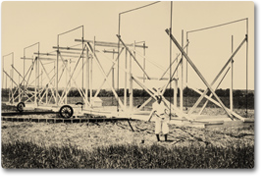
Radio waves have the longest wavelengths in the electromagnetic spectrum. They range from the length of a football to larger than our planet. Heinrich Hertz proved the existence of radio waves in the late 1880s. He used a spark gap attached to an induction coil and a separate spark gap on a receiving antenna. When waves created by the sparks of the coil transmitter were picked up by the receiving antenna, sparks would jump its gap as well. Hertz showed in his experiments that these signals possessed all the properties of electromagnetic waves.
You can tune a radio to a specific wavelength—or frequency—and listen to your favorite music. The radio "receives" these electromagnetic radio waves and converts them to mechanical vibrations in the speaker to create the sound waves you can hear.
RADIO EMISSIONS IN THE SOLAR SYSTEM
Astronomical objects that have a changing magnetic field can produce radio waves. The radio astronomy instrument called WAVES on the WIND spacecraft recorded a day of bursts of radio waves from the Sun's corona and planets in our solar system.
Data pictured below show emissions from a variety of sources including radio bursts from the Sun, the Earth, and even from Jupiter's ionosphere whose wavelengths measure about fifteen meters in length. The far right of this graph shows radio bursts from the Sun caused by electrons that have been ejected into space during solar flares moving at 20% of the speed of light.
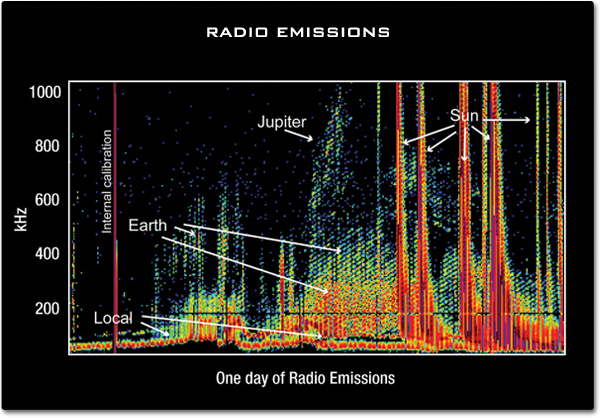
RADIO TELESCOPES
Radio telescopes look toward the heavens to view planets, comets, giant clouds of gas and dust, stars, and galaxies. By studying the radio waves originating from these sources, astronomers can learn about their composition, structure, and motion. Radio astronomy has the advantage that sunlight, clouds, and rain do not affect observations.
Since radio waves are longer than optical waves, radio telescopes are made differently than the telescopes used for visible light. Radio telescopes must be physically larger than an optical telescopes in order to make images of comparable resolution. But they can be made lighter with millions of small holes cut through the dish since the long radio waves are too big to "see" them. The Parkes radio telescope, which has a dish 64 meters wide, cannot yield an image any clearer than a small backyard optical telescope!
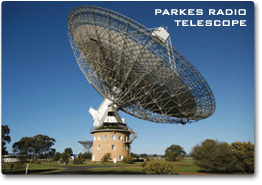
A VERY LARGE TELESCOPE
In order to make a clearer, or higher resolution, radio image, radio astronomers often combine several smaller telescopes, or receiving dishes, into an array. Together, these dishes can act as one large telescope whose resolution is set by the maximum size of the area. The National Radio Astronomy Observatory's Very Large Array (VLA) radio telescope in New Mexico is one of the world's premier astronomical radio observatories. The VLA consists of 27 antennas arranged in a huge "Y" pattern up to 36 km across (roughly one-and-one-half times the size of Washington, DC).
The techniques used in radio astronomy at long wavelengths can sometimes be applied at the shorter end of the radio spectrum—the microwave portion. The VLA image below captured 21-centimeter energy emissions around a black hole in the lower right and magnetic field lines pulling gas around in the upper left.
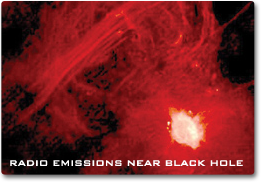
THE RADIO SKY
If we were to look at the sky with a radio telescope tuned to 408 MHz, the sky would appear radically different from what we see in visible light. Instead of seeing point-like stars, we would see distant pulsars, star-forming regions, and supernova remnants would dominate the night sky.
Radio telescopes can also detect quasars. The term quasar is short for quasi-stellar radio source. The name comes from the fact that the first quasars identified emit mostly radio energy and look much like stars. Quasars are very energetic, with some emitting 1,000 times as much energy as the entire Milky Way. However, most quasars are blocked from view in visible light by dust in their surrounding galaxies.
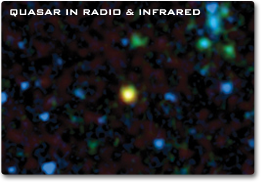
Astronomers identified the quasars with the help of radio data from the VLA radio telescope because many galaxies with quasars appear bright when viewed with radio telescopes. In the false-color image below, infrared data from the Spitzer space telescope is colored both blue and green, and radio data from the VLA telescope is shown in red. The quasar-bearing galaxy stands out in yellow because it emits both infrared and radio light.
Next: Microwaves
National Aeronautics and Space Administration, Science Mission Directorate. (2010). Radio Waves. Retrieved [insert date - e.g. August 10, 2016] , from NASA Science website: http://science.nasa.gov/ems/05_radiowaves
Science Mission Directorate. "Radio Waves" NASA Science . 2010. National Aeronautics and Space Administration. [insert date - e.g. 10 Aug. 2016] http://science.nasa.gov/ems/05_radiowaves
Discover More Topics From NASA
James Webb Space Telescope

Perseverance Rover

Parker Solar Probe

MIT Technology Review
- Newsletters
Radio waves from Earth have reached dozens of stars
As we continue our search for extraterrestrial life, a new study estimates how many other worlds might have already spotted us.
- Tatyana Woodall archive page

For billions of years, Earth has been playing a cosmic game of hide-and-seek.
New research published today in Nature posits that roughly 1,700 stars are in the right position to have spotted life on Earth as early as 5,000 years ago. These stars, within 100 parsecs (or about 326 light-years) of the sun, were found using data from NASA’s Transiting Exoplanet Survey Satellite and the European Space Agency’s Gaia mission.
And with thousands of exoplanets already found orbiting other stars in our universe, could we have already seen life on other planets come and go? Might they have seen us?
“The universe is dynamic,” says Lisa Kaltenegger , director of the Carl Sagan Institute at Cornell, and lead author of the study. “Stars move, we move. First the Earth moves around the sun, but the sun moves around the center of our galaxy.”
About 70% of exoplanets are found using the transit method: when a planet passes between a star and an observer, the star dims enough to confirm the presence of a previously unseen celestial body.
Kaltenegger and coauthor Jackie Faherty of the American Museum of Natural History compiled a list of stars that either will see or already have seen Earth transit in their lifetimes. Of these, they found seven stars with orbiting exoplanets that could potentially be habitable.
Statistically, one out of four stars has a planet that exists in the “Goldilocks zone”—not too hot, not too cold, and just far away from a star to support life. But how do we determine whether faraway exoplanets meet these criteria?
When transiting exoplanets block stellar light, part of that light filters through the atmosphere. Energy and light interact with the molecules and atoms of that planet, and by the time that light reaches an astronomer’s telescope, scientists can determine whether it has interacted with chemicals like oxygen or methane.
A combination of those two, Kaltenegger says, is the fingerprint for life.
“What’s really interesting is people could have seen that the Earth was a habitable planet since about 2 billion years [ago], because of the oxygen buildup in the atmosphere,” she says.
The idea of studying transits to find out if we’re on someone else’s radar isn’t really new. Kaltenegger attributed much of her inspiration to a plan the SETI Institute, which pursues the search for extraterrestrial intelligence, had in the 1960s.
In 1960, a radioastronomer named Frank D. Drake was the first person to try to detect interstellar radio transmissions , focusing on two stars 11 light-years away and similar in age to our sun. Though that attempt was unsuccessful, scientists and amateur enthusiasts have continued to look for such signals ever since.
But whether the signals we send are getting through is another matter entirely. In the new study, Kaltenegger and Faherty reported that human-made radio waves had already swept over the 75 closest stars on their list.
Even though humans have been sending out radio waves for roughly 100 years, that’s nothing compared with Earth’s billions of years of planetary evolution.
Meanwhile, much of our own solar neighborhood is still unexplored, but that’s where missions like TESS, Gaia, and Kepler come in. TESS spends months looking at different sectors of the universe in its hunt to find exoplanets, and Gaia seeks to create a three-dimensional map of the entire Milky Way. But Kepler was made to observe one patch of sky for longer periods of time—the perfect way to track exoplanets using the transit method.
“With both Kepler and Gaia, one of the really big advantages was that they were able to sort of stare for a long time at the stars,” says Douglas Caldwell , a SETI researcher and instrument scientist for the Kepler mission.
Caldwell says missions dedicated to specific science goals like Gaia offer a kind of precision that he hopes will bode well for future astronomical discoveries.
“Space is really, really huge, and these stars are all really far away from us compared to things we’re used to as people,” he says. “We’re looking at our closest neighbors and kind of trying to understand our little neighborhood of the galaxy.”
The search for extraterrestrial life is targeting Jupiter’s icy moon Europa
NASA’s Europa Clipper mission will travel to one of Jupiter's largest moons to look for evidence of conditions that could support life.
- Stephen Ornes archive page
Amplifying space’s potential with quantum
How scientists are using quantum squeezing to push the limits of their sensors.
Fuzziness may rule the quantum realm, but it can be manipulated to our advantage.
- Sophia Chen archive page
How to safely watch and photograph the total solar eclipse
The solar eclipse this Monday, April 8, will be visible to millions. Here’s how to make the most of your experience.
- Rhiannon Williams archive page
Stay connected
Get the latest updates from mit technology review.
Discover special offers, top stories, upcoming events, and more.
Thank you for submitting your email!
It looks like something went wrong.
We’re having trouble saving your preferences. Try refreshing this page and updating them one more time. If you continue to get this message, reach out to us at [email protected] with a list of newsletters you’d like to receive.

Windupradio is supported by its audience. When you purchase via our links, we may get a commission. Learn more
How Fast Do Radio Waves Travel in Space (Explained with FAQs)

Writen by Edwin Jones

Fact checked by Andrew Wright
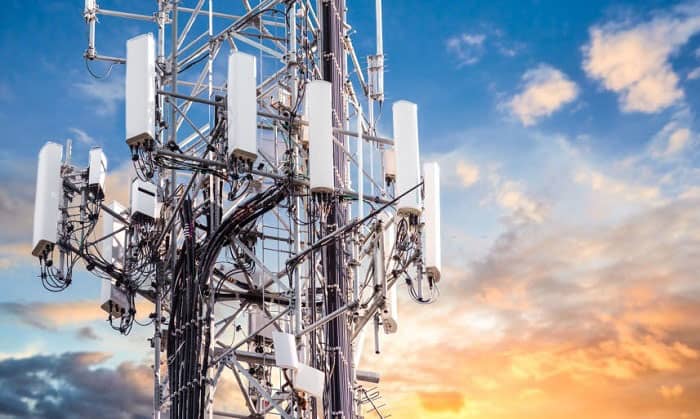
Radio waves play an essential role in most of the technological solutions around you. Unfortunately, very few people know about them; many people do not even know the meaning of radio waves. Therefore, there are a lot of misconceptions about radio waves and their velocity.
This article will provide everything you need to know about radio waves, including how fast do radio waves travel in space.
Table of Contents
What is the Speed of Radio Waves in Space?
What are radio waves, 1. low to medium frequencies, 2. higher frequencies, 3. shortwave radio, 4. highest frequencies, what are the properties of radio waves, 1. do radio waves continue in outer space, 2. does wi-fi take advantage of radio waves, 3. are radio waves the only type of electromagnetic wave, 4. what shape is a radio wave, 5. what are some practical applications of radio waves, 6. what electronics use radio waves, 7. are radio waves from a cell phone harmful.
Radio waves in space travel at the speed of light (c ≈299,79×10^6 m/s). That means the distance radio waves travel in 1 second in space is 299,792,458 meters (983,571,056 ft). So the speed of radio waves is much higher than that of sound waves .
Radio waves can travel through many different media at different speeds. When passing through a medium, the radio wave speed is decreased depending on the medium’s permittivity and permeability.
Radio waves have a wavelength of 0.04 inch to over sixty-two miles. As these waves go farther from the antenna that transmits them, their strength declines.
Contrary to what many people think, radio waves are not the sound you hear from your speakers or radio devices. What you hear are sound waves, not radio waves.
In essence, radio waves are electromagnetic radiation; therefore, they are pretty similar to a light wave . One difference between radio waves and light waves is that you cannot see radio waves.
Physicist James Clerk Maxwell foresaw the existence of radio waves; he created a famous Maxwell’s equation around the 1870s. Later, his prediction of radio waves was advanced by Heinrich Hertz, a German physicist. Heinrich Hertz was also the first to apply Maxwell’s equations to the transmission and reception of radio waves.
The unit of frequency for radio waves was named Hertz (Hz) in honor of Heinrich Hertz.
4 Main Types of Radio Waves
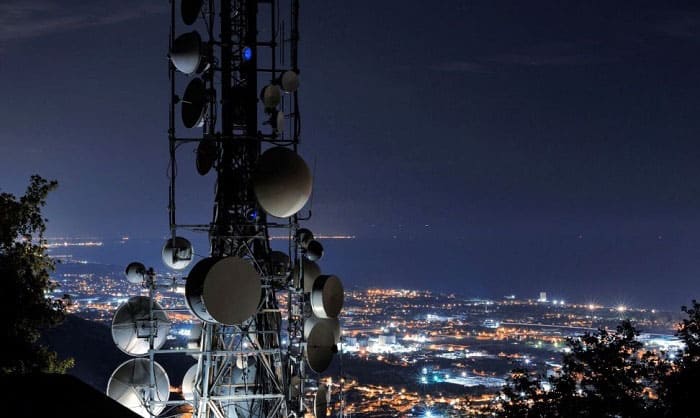
Radio waves are divided into several different types; these include:
These frequencies are the first kind in the radio frequency spectrum; this frequency range covers extremely low to medium radio waves.
ELF stands for extremely low frequency while VLF stands for very low frequency; They operate with frequencies from under 3 to 30 kHz. These frequencies are considered the lowest type of radio frequencies. Moreover, their long-range capability made them suitable for communications equipment in submarines.
In particular, they can penetrate water and rocks. Hence, they have been widely applied in caves and mines.
These frequencies are HF, VHF, and UHF. They are widely used in broadcast audio, public service radio, cell phones, FM, and GPS. As a rule, low frequencies travel farther and propagate better than higher frequencies.
Shortwave radio makes use of frequencies that range from 1.7 MHz to 30 MHz. They are applied in the transmission of radio signals from shortwave stations around the world.
For example, stations like the VOA, BBC, and Voice of Russia use this frequency range for broadcast purposes.
On the other hand, shortwave is also widely used for long-distance broadcast.
These are SHF (Super high frequency) and EHF (extremely high frequency). SHF is widely used in wireless USB, Wi-Fi, and Bluetooth; it is also utilized for radar purposes. In particular, super high frequencies can only operate on straight lines; that means they bounce off any obstacle.
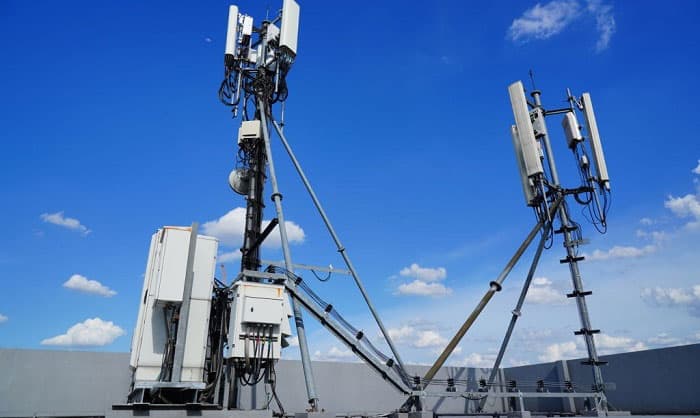
Radio waves come with some very different properties; these include:
- Their wavelength is longer than that of infrared light.
- Can overcome materials or obstacles.
- Can travel great distances.
- They cannot be seen and cannot be felt.
- Moving in a vacuum at the speed of light.
- They can be formed by electric currents (including lightning).
- Possess both electric and magnetic components.
- They can be absorbed, refracted, reflected, as well as polarized.
Frequently Asked Questions

Radio waves can be used to send messages to space. NASA actually uses them for communication.

Wi-Fi, like other wireless devices, applies radio frequencies to send signals between devices. However, the range of radio frequencies applied by Wifi is different from devices such as car radios, cell phones, weather radios, etc.
The short answer is no.
They are not the only components of the electromagnetic spectrum. There are several other forms of electromagnetic waves, including radar, BlueTooth, microwaves, infrared, ultraviolet light waves, and X-rays; all these components are electromagnetic waves.
Like other electromagnetic waves, radio waves look like ocean surface waves or any other type of wave. Wavelength is measured by the distance from the top of a peak to its neighboring peak.
Radio waves are used to transmit radio signals that your radio can pick up. In addition, they also work in carrying the signals you use for your smartphones and TVs.
There are devices that use radio waves for communication, such as two-way radios, television broadcasts, radio broadcasts, cellular telephones, cordless telephones, garage door openers, satellites, and countless other devices.
Some studies show that radio waves from cell phones can affect the metabolism of brain cells. However, there is no evidence that this effect is harmful.
Hopefully, after you finish reading this article, you will be confident enough to answer when someone asks you “how fast do radio waves travel in space” or “do radio waves travel at the speed of light?”
Thank you for reading. Please share this article if you find it helpful.

Hi, I am Amaro Frank – the Wind Up Radio’s content editor and writer. Working with Adam is so much fun, as his stories and experiences enrich my knowledge about radio communications and radio accessories. My main tasks in Wind Up Radio are building content and generating great articles on different topics around radio accessories.
Small Business Productivity, Tools and Tips – Android and iPhone Sync
What radio waves can travel through and what they cannot.
When Guglielmo Marconi began research into long-range radio in the late 19th century, the scientific community was skeptical. That he succeeded in transmitting radio signals more than 2000km met with much astonishment. What he had unwittingly done was discover the ionosphere, a layer in the atmosphere that is ionized to a degree by the sun’s ultraviolet rays.

This affects radio waves and reflects them to earth, which bounces them upwards again. This repeated sequence enables us to transmit radio waves around the world. So, if radio waves can’t penetrate the ionosphere, what else will hinder them? Let’s look at what radio waves consist of, and then we’ll talk about their ability or otherwise to pass through certain materials.
Radio Waves Explained
Developments in radio technology have brought us a long way in the past 100 years and more, but how do radio waves work? Before Marconi’s discovery, scientists believed that radio signals could only travel a straight line, as they were known to do in free space. Hence, there was a necessity for tall towers from which to transmit signals. A 100m high tower, for example, could send a signal up to around 30km, the limit set by the curvature of the earth. Marconi showed that radio waves could be bent and bounced by the ionosphere.
Radio waves form a small part of what is known as the electromagnetic spectrum (EMS). This consists not just of radio waves but also other forms of electromagnetic radiation such as gamma rays, microwaves, visible light, and more. Radio waves have among the longest wavelengths on the EMS. Imagine a rope held between two people. Move the rope up and down at one end, and a waveform moves across the rope.
This is what a radio wave would look like if we could see it. The wavelength is the distance between two ‘peaks’ in the wave. We also have to consider the frequency, which the number of waves that pass a given point in a set time. This is vital to understand so that different transmissions do not interfere with each other.
Television signals are radio waves, but they are broadcast in a different frequency range to the radio.
What has this to do with the materials that radio waves can and cannot pass through? Let’s look more closely at this.

What Can’t Radio Waves Pass-Through?
We’ve already seen that radio waves do not penetrate the ionosphere. We should explain that this refers to radio waves of up to 40MHz, the highest frequency bounced off the ionosphere. Why do radio waves bounce back?
As we mentioned, the ionosphere is partly ionized.
This is because the UV light from the sun causes electrons to shake free from atoms, leaving a large proportion of free electrons hanging about in the ionosphere. When a radio wave hits the ionosphere, the energy created by the free electrons, as a result, causes the radio waves to be repelled or reflected.
So, we know that radio waves up to 40MHz won’t pass through an ionized layer in the atmosphere. Remember that we explained the perceived limitations of radio transmissions before Marconi’s discovery. A line of sight was necessary, without obstructions, for successful transmission.
In some radio transmissions, interference can be caused by the waves being blocked by materials that they cannot penetrate. While radio waves can move through wood, bricks, and concrete to a certain extent, these materials can still cause interference. This is because radio waves meeting such objects can be reflected from buildings and other large structures, just like the ionosphere. This explains why the reception of radios and other radio frequency devices such as smartphones vary between locations.
For the record, as it covers a large bandwidth necessarily, television signals need to be above 40MHz so they cannot be bounced off the ionosphere, hence the tall towers in high locations used for TV transmissions.
Radio waves will also be adversely affected by metal and water, which they cannot pass through. That is because water and metal are both electrical conductors. Like the ionosphere, metal and water contain many free electrons, which will vibrate when a radio wave hits the surface, and the wave will bounce back.
To summarize, we now know that radio waves are affected by free electrons in electrical conductors such as metals and water and cannot pass through these materials.
We have discovered that they can pass through non-conducting materials quite well but are losing propagation power with reflecting surfaces such as water, metal, and other materials. Furthermore, worldwide radio transmission is made possible by the radio waves being reflected by the ionosphere and the earth in a continuous sequence, allowing for transmissions to be made across great distances.
Comments are closed.
How far can shortwave radios travel
Today, we will be discussing about a certain topic and explaining everything about it. Namely, many of you have wanted to find out how far shortwave radios can actually travel . Some of you are new to this hobby, and, if you are a passionate person, you should definitely stick around and see what new things can you learn today.
So, basically, shortwave radio signals are able to travel far and have a very long range. It is known that shortwave radio signals are even able to bounce off surfaces or reflect on the water. That is why these signals can even last and travel forever! But about that later.
So, here are some of the topics that we will be discussing today:
- Intro to shortwave radios
How do shortwave radios work
- How far can a Shortwave radio reach, different frequencies
- The conclusion
Basic information about shortwave radios
If you are just at the beginning of this wonderful hobby, you might need some more info about what shortwave radios actually are , and what is their principle of working. Basically, we could go on all day about what shortwave radios actually represent and how much they have brought to the table after they have been invented. But, we will have to cut that story short.
So, shortly, shortwave radios are radios that are able to catch and transmit shortwave radio frequencies . Those radio frequencies are special radio frequencies that can only be caught by shortwave radios and no other devices. These signals can, in fact, reflect on the water and travel around the world. That is why shortwave radios can basically transmit and receive radio station signals from stations from all around the globe.
With that being said, a user will be able to listen to news from any country in the world, for example. But, more about the range will be said later in the article.

As we have previously mentioned, shortwave radios have the ability to catch signals from all around the world. You might wonder how that is possible well the explanation is very simple and complicated at the same time.
To make things easier for you to understand, we will explain it like this. Can you imagine a wave that is moving towards the shore, now imagine you standing at some distant point in the sand? If waves are stronger (have higher frequencies), the wave will be able to reach out to your feet and wet them. Well, when we translate that into radio language, the electromagnetic waves that have different lengths and frequencies are able to bounce off of different surfaces and eventually travel through the air.
That is why even you with the smallest shortwave radio will be able to catch a shortwave signal from all across the Earth. That is simply the way that electromagnetic waves work. And, if you are interested in finding out more about it, you should maybe consider studying physics for a bit because then you will understand the nature of waves, their frequencies, and how they work fully.
How far can a Shortwave radio reach
The range of one shortwave radio may depend on many factors. Usually, the range is determined by the quality of a shortwave radio, the manufacturer, and of course, the technology that that particular shortwave radio uses.
Speaking in general, shortwave radios are able to tune into broadcasts of signals from any position across the Earth. Some shortwave radios are even able to catch skywave or aircraft radio signals that are bouncing off of the surface of the Earth right back into the air.
When you give it a little bit of thought, you will realize that shortwave radios are able to even catch signals from the farthest point from you. That means that, if you are located, for example, somewhere in Australia, you will easily manage to listen to the live broadcasts from the US shortwave radio stations, check here.

If we want to talk in numbers, the exact frequency of shortwave radio signals that shortwave radios can catch can vary from model to model. But, for example, you will be able to find shortwave radios that can be used for very long-distance communication While, on the other hand, you will also stumble upon some models that have a limited reach and can catch shortwave signals with a transmission source of around 64km, or 40 miles .
The good thing is that, in general, all kinds of broadcasting shows, such as the news, entertainment shows, and even emergency broadcasts can all be caught and streamed through shortwave radio. In other words, from all of this, we can easily conclude that shortwave radios are being used for long-distance voice communication.
If you are thinking of making shortwave radios more than a hobby, you might need to consider purchasing serious, professional shortwave radios and avoid the amateur ones. Professional shortwave radios might be a little more expensive, but, they for certain have a longer range and a higher frequency reception.

You May Also Like
- Best Shortwave radio stations
- The best shortwave radio reviews
Final words
Finally, we can only hope that we have been able to answer the question posed by many of our dear readers and that you know understand how and why shortwave radios are able to travel far. As you could have seen, these signals are quite delicate, and there are no other similar to them invented or discovered yet.
Shortwave radios have been found back at the start of the 20 th century, and you can definitely see that they have come quite a long way and are still used widely today. If shortwave radios have become your hobby, we wish you nothing but fun times spent with them trying to figure out how they work and bring their usage to your everyday routine!
Stay tuned for more articles about shortwave radios are coming your way soon!
Q-1. Do radio signals travel forever?
In theory, yes, signals are able to travel forever. But, in today’s age, we actually do not have all of the necessary equipment and the technology to see how far and how long radio signals are actually able to travel. Let’s hope that that sort of thing will be invented in the close future.
Photo source: amazon.com
About The Author
Robert Smith
Enjoy this blog? Please spread the word :)
- The Inventory
Why Do Radio Signals Travel Farther at Night Than in the Day?
Not all radio waves travel farther at night than during the day, but some, short and medium wave, which AM radio signals fall under, definitely can given the right conditions. The main reason this is the case has to do with the signal interacting with a particular layer of the atmosphere known as the ionosphere, and how this interaction changes from the nighttime to the daytime.
The ionosphere is a layer of the upper atmosphere about 50 to 600 miles above sea level. It gets its name because it is ionized consistently by solar and cosmic radiation. In very simple terms, X-ray, ultraviolet, and shorter wavelengths of radiation given off by the Sun (and from other cosmic sources) release electrons in this layer of the atmosphere when these particular photons are absorbed by molecules. Because the density of molecules and atoms is quite low in the ionosphere (particularly in the upper layers), it allows free electrons to exist in this way for a short period of time before ultimately recombining. Lower in the atmosphere, where the density of molecules is greater, this recombination happens much faster.
What does this have to do with radio waves? Without interference, radio waves travel in a straight line from the broadcast source, ultimately hitting the ionosphere. What happens after is dependent on a variety of factors, notable among them being the frequency of the waves and the density of the free electrons. For AM waves, given the right conditions, they will essentially bounce back and forth between the ground and the ionosphere, propagating the signal farther and farther. So clearly the ionosphere can potentially play an important part in the terrestrial radio process. But it is the constantly shifting nature of the ionosphere that makes things really interesting. And for that, we'll have to get a little more technical, though we'll at the least spare you the math, and we'll leave out a little of the complexity in an effort to not go full textbook on you.
In any event, the ionosphere's composition changes most drastically at night, primarily because, of course, the Sun goes missing for a bit. Without as abundant a source of ionizing rays, the D and E levels (pictured right) of the ionosphere cease to be very ionized, but the F region (particularly F2) still remains quite ionized. Further, because the atmosphere is significantly less dense here then the E and D regions, it results in more free electrons (the density of which is key here).
When these electrons encounter a strong AM radio wave, they can potentially oscillate at the frequency of the wave, taking some of the energy from the radio wave in the process. With enough of them, as can happen in the F layer, (when the density of encountered electrons is sufficient relative to the specific signal frequency), and assuming they don't just recombine with some ion (which is much more likely in the E and D layers in the daytime), this can very effectively refract the signal back down to Earth at sufficient strength to be picked up on your radio.
Depending on conditions, this process can potentially repeat several times with the signal bouncing down to the ground and back up. Thus, using this skywave, rather than just the normal daytime groundwave, AM radio signals can be propagated even thousands of miles.
Of course, this can become a major problem given that there are only a little over 100 allowed AM radio frequencies (restricted to keep signals interfering too much with one another), but around 5,000 AM radio stations in the United States alone. Given that at night, the signals from these stations can travel vast distances, this is just a recipe for stations interfering with one another. As a result, at night, AM stations in the United States typically reduce their power, go off the air completely until sunrise the next day, and/or possibly are required to use directional antennas, so their specific signal doesn't interfere with other stations on the same frequency. On the other hand, FM stations don't have to do any of this as the ionosphere doesn't greatly affect their signals, which has the side benefit (or disadvantage, depending on your point of view) of severely limiting the range of the FM signals, which rely on groundwave propagation.
If you liked this article, you might also enjoy:
- The "War of the Worlds" Mass Panic That Never Really Happened
- When the U.S. Sent Several Hundred Million Needles Into Space (Project West Ford)
- How One of the Most Beautiful Women in 1940s' Hollywood Helped Make Certain Wireless Technologies Possible
- The 72 Second Message from Outer Space
- How the Gun on the Original Duck Hunt Game Worked
Bonus Fact:
- AM Radio (Amplitude Modulation) was the first type of radio broadcasting used for mass-consumption by the public and is still widely used today. (Although AM radio is becoming less widespread in America, it is still the dominant type of terrestrial radio broadcasting in some countries, like Australia and Japan.) This type of signal works with the receiver translating and amplifying amplitude changes in a wave at a particular frequency into the sounds you hear coming from your speakers. FM Radio (Frequency Modulation), which started coming into its own in the 1950s, is broadcast in much the same way that AM is, but the receiver processes changes in the frequency of a wave, as opposed to the amplitude.
Dan Eder writes for the wildly popular interesting fact website TodayIFoundOut.com . To subscribe to Today I Found Out's "Daily Knowledge" newsletter, click here or like them on Facebook here . You can also check 'em out on YouTube here .
This post has been republished with permission from TodayIFoundOut.com . Image by Kenji Yamamoto under Creative Commons license.
- Our Podcasts

The Takeaway
What aliens would hear if they intercepted our radio waves.
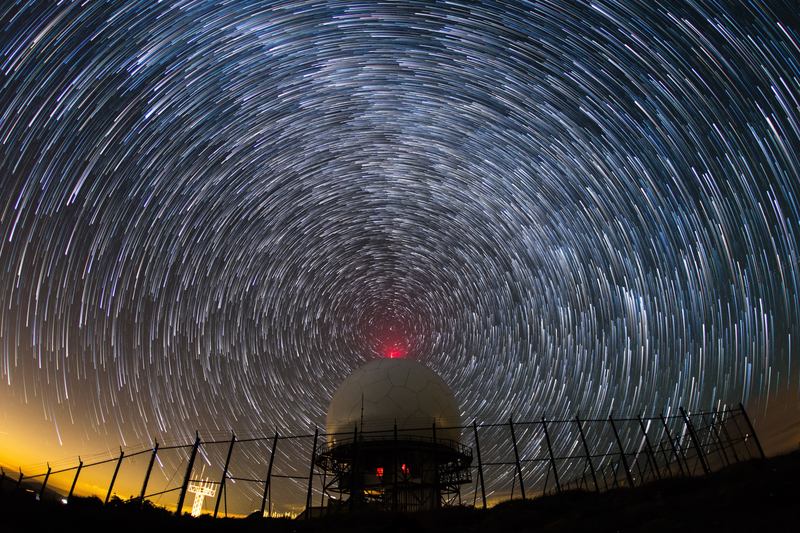

- Planet Earth
- Strange News
How Fast Do Radio Waves Travel Through Space
Table of Contents:
Map reveals how long it takes radio waves to travel through space . Called Lightyear.fm, the project (pictured) was created by New York-based computer designers Brian Moore and Chris Baker with Mike Lacher and Mikhail Chernov.
Using 110 years of Billboard chart data, designers have created a stunning and mesmerising website that reveals how long it would take popular tracks to travel through the universe. Called Lightyear. fm, it is based on the premise that the radio waves travel at the speed of light, so if you were one light year away from Earth you’d only just be hearing songs released a year ago. The planets in our solar system are mere light-minutes from Earth – meaning many would be receiving broadcasts made this year from the likes of Taylor Swift and The Weeknd – but as Lightyear. fm journeys beyond our system and into the depths of the Milky Way classic tunes echo around. Click Play on the module below to take the musical tour through the Milky Way. It works best on the Chrome browser Lightyear. fm (above) is based on the premise that the radio waves travel at the speed of light, so if you were one light year away from Earth you’d only just be hearing songs released a year ago. The project -inspired by the opending credits of the 1997 film Contact -was created by New York-based computer designers Brian Moore and Chris Baker with Mike Lacher and Russia-based Mikhail ChernovThe project – inspired by the opening credits of the 1997 film Contact – was created by New York-based computer designers Brian Moore and Chris Baker with Mike Lacher and Russia-based Mikhail Chernov.
Video advice: How Radio Waves Could Help Clear the Way to Space
There is an invisible shell of radiation surrounding our planet that can wipe out satellites and could endanger future explorers. One possible solution to this problem? Good, old-fashioned radio waves.

Electromagnetic waves chapter 12 Flashcards
study test Learn with flashcards, games, and more — for free.
- Terms in this set (42)
- Electromagnetic Waves
- Chapter 5 (Heat)
- Science vocabulary
- Science: Ch. 12
- Electromagnetic Radiation Ch.
- Chapter 12 Electromagnetic Waves
- The nation’s sick Economy chapter 14
- American History Chapter 13 Vocabulary
Upgrade to remove adsOnly RUB 2,325/yearSTUDYFlashcardsLearnWriteSpellTestPLAYMatchGravitystudy testTerms in this set (42)What are electromagnetic wavesmade by vibrating electric charges and can travel through space where matter is not present Electromagnetic waves are produced when an electric charge that moves back and forthWhat are electromagnetic wavesAn electromagnetic wave is a transverse wave. Properties of Electromagnetic WavesAll objects emit electromagnetic wavesWave frequency increases as the temperature of the material increasesradiant energyThe energy carried by an electromagnetic wave is called radiant energy. wave of speedAll electromagnetic waves travel at 300,000 km/s in the vacuum of space. (“Speed of light. “)wave of speedNothing travels faster than the speed of light. Wavelength and FrequencyThe wavelength of an electromagnetic wave is the distance from one crest to another. Waves and ParticlesThe difference between a wave and a particle might seem obvious a wave is a disturbance that carries energy, and a particle is a piece of matter.
How long would it take a radio wave to travel?
The distances to be traveled are so great that even light or radio waves take a while getting there. It takes around eight minutes for radio waves to travel from the Earth to the Sun, and four years to get from here to the nearest star.
Radio waves possess the longest wavelengths within the EM spectrum, based on NASA, varying from about . 04 inches (1 millimeter) to greater than 62 miles (100 kilometers). They likewise have the cheapest frequencies, from about 3,000 cycles per second, or 3 kilohertz, as much as about 300 billion hertz, or 300 gigahertz.
How long would it take a radio wave to travel? How far does a radio wave travel in one year? How many seconds would it take a radio wave to travel from the planet Mars to Earth when they are the closest? How fast do radio signals travel through space? How fast does red light travel in a vacuum? Do radio waves travel forever? How far does radio travel? What are the 7 minutes of terror? Do radio signals travel forever? Does redlight travel faster? How long does it take for a radio wave to travel? How long does it take for a radio wave to reach Mars? How are radio waves picked up in space? What is the speed of a radio signal?
Question: How Fast Do Radio Waves Travel Through Space
Light waves, radio waves and all of the other electromagnetic waves travel at the speed of light—about 300,000,000 meters per second!. Can radio waves travel through empty space? Electromagnetic waves.
Although the sciences generally classify EM waves into seven fundamental types, each one is manifestations of the identical phenomenon. Radio Waves: Instant Communication. Microwaves: Data as well as heat. Infrared Waves: Invisible Heat. Visible Light Sun rays. Ultraviolet Waves: Energetic Light. X-sun rays: Penetrating Radiation. Gamma Sun rays: Nuclear Energy.
Video advice: How do Radios Work?
Patreon: patreon.com/ConcerningReality

Can radio waves travel through empty space? How far do radio waves travel in 1 second? How long does it take a radio wave to travel one light year? How long does it take radio waves to reach Mars? Are radio waves faster than sound waves? What radio waves travel the farthest? How far can radio waves transmit? How fast do radio waves travel to the moon? HOW FAR CAN signals travel in space? How do radio waves propagate through space? Do all waves travel at the same speed? How long does it take a radio signal to reach Pluto? How long would it take to get to Pluto at the speed of light? How long is the communication delay between Earth and Mars? Do all radio waves travel at the speed of light? Are radio waves faster than the speed of light? Do microwaves travel at the speed of light? Can humans pick up radio signals? What are microwave frequencies? What are the 7 types of waves? Can a radio wave travel through the earth? Do radio waves ever stop?
Device Makes Radio Waves Travel Faster Than Light
(/caption) A scientist has created a gadget that can make radio waves travel faster than light. Einstein predicted that particles and information can’t travel faster than the speed of light, but phenomena like radio waves are a different story, said John Singleton, who works at the Los Alamos National Laboratory. The polarization synchrotron combines the … Continue reading “Device Makes Radio Waves Travel Faster Than Light”
One possible use for quicker than light radio waves — that are packed right into a very effective wave how big a pencil point — may be the development of a brand new generation of mobile phones that communicate straight to satellites, instead of transmitting through relay towers because they now do.
A scientist has created a gadget that can make radio waves travel faster than light. Einstein predicted that particles and information can’t travel faster than the speed of light, but phenomena like radio waves are a different story, said John Singleton, who works at the Los Alamos National Laboratory. The polarization synchrotron combines the waves with a rapidly spinning magnetic field, and the result could explain why pulsars — which are super-dense spinning stars that are a subclass of neutron stars — emit such powerful signals, a phenomenon that has baffled many scientists.
How Do Radio Waves Travel From One Radio to Another?
Please explain how this occurs.
You will find naturally sourced radio waves within nature, but we are able to create artificial radio waves having a transmitter, just like an AM or Radio or perhaps an RFID readers. The transmitter emits waves in a particular frequency, for example 13. 56 MHz. An antenna is needed to get the signal. Since all waves inside the spectrum are striking the antenna, the antenna must be tuned for this particular frequency. When the antenna continues to be tuned, the waves reaching the antenna may then be converted into information.
06. Radio Versus Sound Waves
Radio waves are produced by moving charged particles. An example of this is an electric current in a wire. This can be demonstrated with a wire, a 6-volt battery and a small radio. Turn the radio on AM so that static can be heard, attach one end of the wire to the battery. Touch the other end of the wire to the other battery terminal and have students record their observations. (When the other end of the wire is touched to the other battery terminal, you will hear the radio waves, which reach the radio get turned into sound waves, which your ears can hear.)
Draw an image from the last experiment. Inside your drawing include both people, their ears, their walkie-talkies, and also the balloon. Show the pathways from the seem waves one color as well as radio stations waves utilizing a different color. Out of your drawing, explain the reason why you first heard this balloon mechanism pop around the walkie-talkie.
- Grade Level:
- Curriculum Standards:
- Students will:
- Internet Sites:
- Procedures:
- Evaluation:
Radio waves are produced by moving charged particles. An example of this is an electric current in a wire. This can be demonstrated with a wire, a 6-volt battery and a small radio. Turn the radio on AM so that static can be heard, attach one end of the wire to the battery. Touch the other end of the wire to the other battery terminal and have students record their observations. (When the other end of the wire is touched to the other battery terminal, you will hear the radio waves, which reach the radio get turned into sound waves, which your ears can hear. ) Sound waves travel through a medium. If there is no medium then there will be no sound. Show the included video of a bell in a vacuum. When all air is removed there is no medium for the sound waves to travel through so no sound is heard.
Video advice: GCSE Physics – Radio Waves #65
In this video we cover:

Can radio waves travel through empty space?
Electromagnetic waves differ from mechanical waves in that they do not require a medium to propagate. This means that electromagnetic waves can travel not only through air and solid materials, but also through the vacuum of space . ... This proved that radio waves were a form of light!
How long does it take for a radio wave to travel one light year?
Called Lightyear.fm, it is based on the premise that the radio waves travel at the speed of light, so if you were one light year away from Earth you'd only just be hearing songs released a year ago....
How far do radio waves travel in 1 second?
the distance a radio wave travels in a vacuum, in one second, is 299,792,458 meters (983,571,056 ft) , which is the wavelength of a 1 hertz radio signal.
How fast do communication signals travel in space?
Communications don't occur instantaneously. They're bound by a universal speed limit: the speed of light, about 186,000 miles per second . For spacecraft close to Earth, this time delay — or communications latency — is almost negligible.
How long does it take radio waves to reach Mars?
about 5 to 20 minutesIt generally takes about 5 to 20 minutes for a radio signal to travel the distance between Mars and Earth, depending on planet positions.
Related Articles:
- How Fast Do Radio Waves Travel In Space
- How Far Can Radio Waves Travel On Earth
- How Fast Do Asteroids Travel In Space
- How Fast Does Light Travel In Space
- How Fast Does Light Travel Through Space
- How Fast Do Rockets Travel In Space
Science Journalist
Science atlas, our goal is to spark the curiosity that exists in all of us. We invite readers to visit us daily, explore topics of interest, and gain new perspectives along the way.
You may also like

How To Increase Range Of Vex Robotics Controller

What Is Service Innovation And Design

Are There Software Development Platform For Robotics
Add comment, cancel reply.
Your email address will not be published. Required fields are marked *
Save my name, email, and website in this browser for the next time I comment.
Recent discoveries

How Hard Is Intro To Robotics Csuf

Why Chemistry Is Called Central Science

What Is Calvin Cycle In Biology

What Was Louis Pasteur’S Major Contribution In Science
- Animals 3041
- Astronomy 8
- Biology 2281
- Chemistry 482
- Culture 1333
- Health 8466
- History 2152
- Physics 913
- Planet Earth 3239
- Science 2158
- Strange News 1230
- Technology 3625
Random fact

Investigators Link COVID-19 and Chance of Bloodstream Clot Formation

How Fast Do Radio Waves Travel in Space? – Explained
How fast do radio waves travel in space? Do radio waves travel at the speed of light?
Yes, they do. The speed of radio waves in space is exactly the speed of light, which is about 300,000,000 meters per second.
Table of Contents
The Speed of Radio Waves in Space

On a clear night, you can see thousands of stars when looking up at the sky. Regardless of how vast the sky feels to your eyes, what you see is only a tiny portion of the electromagnetic spectrum – the whole range of different light waves that exist.
The electromagnetic spectrum includes infrared radiation, microwaves, ultraviolet radiation, X-rays, gamma rays, and radio waves, all of which travel at the speed of light – 299,792,458 meters per second.
Radio signals take 8 minutes to travel from the Earth to the Sun, and from 5 to 20 minutes to travel from the Earth to Mars. The time varies because planets are constantly moving, and this affects their distances.
Additionally, don’t mistake radio waves for sound waves. Even though people say “listen to the radio”, what you hear is sound waves. You can’t see, hear, or feel radio waves.
Sound only travels at 343 meters per second. This means that in the time sound travels the length of a football field, radio waves can travel almost three rounds around the Earth. Plus, radio waves travel in a vacuum, while sound waves can’t.
How Radio Waves Help With Space Exploration
1. communication between spacecraft and the earth.
Have you ever wondered how spacecraft communicate with the Earth? When a spacecraft send out a message, it travels through space as radio waves.
The waves will become weaker when they get close to Earth. Thus, NASA must equip huge radio receivers that are aimed precisely to gather the radio waves from space. This process is similar to when stations send out radio signals, and you receive them with a radio tuner.
On Earth, NASA has to aim transmissions toward the spacecraft to send a message back. Each spacecraft has a radio wave transmitter and receiver, so astronauts can hear or read the message after the radio waves travel through space.
2. Radio telescopes
Radio telescopes have helped enhance our perception of the universe for decades.
Matters and phenomena in space are not always visible to human eyes. If you tune a radio telescope to 408 Hz and look at the sky, it will appear vastly different. Instead of bright lights of the stars, you will see distant pulsars, supernova remnants covering the sky, and even the birth of a new star.
Radio telescopes can also detect changing magnetic fields of other planets. They show us the gas and dust that swirl around Uranus and Neptune, upcoming comets, and how they move.
When astronomers continue to look farther with radio telescopes, they can see much more into the universe, such as black holes and the details of dark energy.
3. Sending messages into the Universe
Scientists have been transmitting radio waves into space for over 100 years. Our signals have passed more than 1,000 stars. Anyone orbiting the nearby stars with a good receiver could have detected the signals and know that we were here.
Although it is controversial whether scientists should try to talk to aliens or not, we can’t deny the significant role radio waves play in human civilization.

1. Do radio waves dissipate?
Yes, they do. When traveling long distances or bouncing back from obstacles, radio waves dissipate. After three to four bounces, radio signals will be weaker than the background noise at that frequency. The signal will then fade into the background. This happens even with powerful transmitted signals.
2. How do the waves work when I listen to the radio?
Stations transmit radio waves into the air. Then, when you tune the radio to your favorite station, the tuner receives the signals and vibrates the speaker, converting them to the sound waves you hear.
3. How fast do radio waves travel to the moon?
The speed of radio waves in meters per second is approximately 300,000,000. The average distance between Earth and the Moon is 384,400,000 meters.
Thus, it takes only over a second for radio waves to travel the distance. But the time can be longer than expected (from 2.4 to 2.7 seconds) due to echo delay.
4. How fast do radio waves travel in the atmosphere?
Radio waves travel at nearly that same speed when they are in the atmosphere. But they slow down when they travel through obstacles, conductors, waveguides, and circuits.
How fast do radio waves travel in space? Radio wave speed is approximately 300,000,000 meters per second. It travels in a vacuum at the speed of light, which is the highest velocity that exists.
The discovery of radio waves has opened up a new era of space exploration. These waves break the limits of distance communications and observations.
Share your thoughts with us in the comment section. Will mankind invent particles that beat the speed of radio waves?
Leave a Comment Cancel reply
Save my name, email, and website in this browser for the next time I comment.

IMAGES
VIDEO
COMMENTS
I was studying this radio receiver circuit Then I read that radio waves broadcasted by radio stations will keep traveling in the air forever unless absorbed by something and that radio waves can penetrate most things. I wonder that if, some radio waves broadcasted some years ago are not absorbed by anything till now, can they still be traveling in the air now and like, be picked up by this ...
Wow. Extent of human radio broadcasts Humans have been broadcasting radio waves into deep space for about a hundred years now, since the days of Marconi. That, of course, means there is an ever-expanding bubble announcing Humanity's presence to anyone listening in the Milky Way. This bubble is astronomically large (literally), and currently ...
Radio propagation is the behavior of radio waves as they travel, or are propagated, from one point to another in vacuum, or into various parts of the atmosphere. [1] : 26‑1 As a form of electromagnetic radiation, like light waves, radio waves are affected by the phenomena of reflection, refraction, diffraction, absorption, polarization, and ...
The Milky Way stretches between 100,000 and 180,000 light-years across, depending on where you measure, which means a signal broadcast from one side of the galaxy would take 100,000 years or more ...
Do Radio Waves Travel Forever in Space? In space, radio waves will keep traveling infinitely. In fact, early radio signals from Earth have already traveled 303 trillion kilometers through space, way past our nearest neighboring star. On Earth, scientists use giant radio telescopes to listen for signals from distant galaxies.
Many people wonder how radio waves can travel around the Earth or through it. In this physics.stackexchange.com question, you can find some answers based on the concepts of electromagnetism, refraction, and attenuation. Learn how different types of radio waves behave in different media and frequencies, and how they are used for communication and navigation.
Kaltenegger and Faherty say 75 stars systems that can see us, or soon will, sit within this 100 light year sphere. Astronomers have already observed exoplanets orbiting four of them. These systems are generally well studied. The researchers say, for example, that the Ross128 star system is the 13th closest to the Sun and the second closest with ...
Radio waves have the longest wavelengths in the electromagnetic spectrum. They range from the length of a football to larger than our planet. Heinrich Hertz proved the existence of radio waves in the late 1880s. He used a spark gap attached to an induction coil and a separate spark gap on a receiving antenna. When waves created by the sparks of ...
In the new study, Kaltenegger and Faherty reported that human-made radio waves had already swept over the 75 closest stars on their list. Even though humans have been sending out radio waves for ...
Radio waves in space travel at the speed of light (c ≈299,79×10^6 m/s). That means the distance radio waves travel in 1 second in space is 299,792,458 meters (983,571,056 ft). So the speed of radio waves is much higher than that of sound waves. Radio waves can travel through many different media at different speeds.
Before Marconi's discovery, scientists believed that radio signals could only travel a straight line, as they were known to do in free space. Hence, there was a necessity for tall towers from which to transmit signals. A 100m high tower, for example, could send a signal up to around 30km, the limit set by the curvature of the earth. ...
The reason is there are too many variables! Any signal that passes by a sun or pulsar can be totally wiped out by the strong electromagnetic noise they produce. Another problem is that decay of radio signals even without interference is not a simple thing to calculate, it really requires testing in the environment the signal will encounter.
Q-1. Do radio signals travel forever? In theory, yes, signals are able to travel forever. But, in today's age, we actually do not have all of the necessary equipment and the technology to see how far and how long radio signals are actually able to travel. Let's hope that that sort of thing will be invented in the close future.
Dan Eder - TodayIFoundOut.com. Published January 27, 2015. Comments ( 13) Not all radio waves travel farther at night than during the day, but some, short and medium wave, which AM radio signals ...
What Aliens Would Hear if They Intercepted Our Radio Waves. Once radio waves are transmitted from Earth, they travel indefinitely through space. Click on the audio player above to hear this interview. In the last century or so, Earth has become a very noisy planet. Once radio waves are transmitted from Earth, they travel indefinitely through ...
How far do radio waves travel? the distance a radio wave travels in a vacuum, in one second, is 299,792,458 meters (983,571,056 ft), which is the wavelength of a 1 hertz radio signal. A 1 megahertz radio wave (mid-AM band) has a wavelength of 299.79 meters (983.6 ft).
It takes around eight minutes for radio waves to travel from the Earth to the Sun, and four years to get from here to the nearest star. Radio waves possess the longest wavelengths within the EM spectrum, based on NASA, varying from about . 04 inches (1 millimeter) to greater than 62 miles (100 kilometers).
The earliest radio waves emitted from earth are currently about 200 light years away. However as mentioned before they will keep going forever getting harder and harder to detect as time passes. ye_olde_astronaut. • 7 yr. ago. They will travel forever radiating from the Earth at the speed of light.
1. Radio wave and light wave are the same thing. They all are electromagnetic radiation, the only difference between them is frequency. My question : 1, is there any photon-like thing for radio wave? 2, how far can they travel in vacuum space? Thanks. visible-light. waves. photons. space.
The electromagnetic spectrum includes infrared radiation, microwaves, ultraviolet radiation, X-rays, gamma rays, and radio waves, all of which travel at the speed of light - 299,792,458 meters per second. Radio signals take 8 minutes to travel from the Earth to the Sun, and from 5 to 20 minutes to travel from the Earth to Mars.